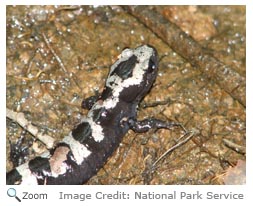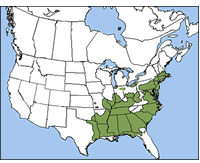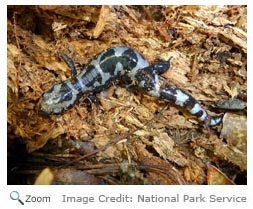Marbled Salamander - Ambystoma opacum |
|||||||||
Description
Range |
HabitatThe marbled salamander lives in forests and woodlands. It is found in a variety of habitats, from moist sandy areas to dry hillsides. It spends most of its time in a burrow, in leaf litter, or under bark or a log. DietAdult marbled salamanders eat invertebrates including earthworms, slugs, snails, centipedes, and a variety of insects. Larvae eat zooplankton. As they grow larger, they eat tadpoles, insects, and other salamander larvae. Life Cycle
BehaviorExcept for during breeding season, marbled salamanders are solitary creatures. |
||||||||


 The marbled salamander is found from southern New Hampshire to northern Florida, and west to southern Illinois, southeast Oklahoma, and east Texas. It is also found around Lake Erie and Lake Michigan and in southwest Missouri and along the northern border of Ohio and Indiana.
The marbled salamander is found from southern New Hampshire to northern Florida, and west to southern Illinois, southeast Oklahoma, and east Texas. It is also found around Lake Erie and Lake Michigan and in southwest Missouri and along the northern border of Ohio and Indiana.
